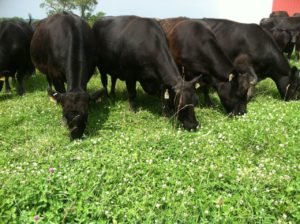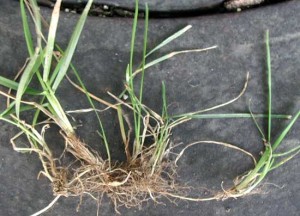Several days ago we had “just one more” chore: letting the cows into the hay lot behind Wesley’s house so they could eat the grass down. There is no fence between the hay lot and hay field so we put up some fake
electric fence and parked the truck on the outside of it where we could sit and watch the cows eat.
Mob Grazing
I fixed us both an adult beverage – it was way past five o’clock, maybe six or seven. I sat on the back of the pickup truck while Jeanne called the cows. Within minutes the cows started filing into the small lot and once the first couple of cows began eating the lush plants the other cows quickened their pace.
The cellulose-digesting mobile protein-factories were munching down. I like to watch them eat, especially with an adult beverage.
So Many Grasses
I was curious as to what they would prefer to eat. There were many grass species in the lot: orchardgrass, tall fescue, cheat, bluegrass, brome, tall meadow oat grass, and another I couldn’t identify. Broadleaf plants included wild mustard, musk thistle, Virginia pepperweed and others.
There was one clump of grass (the one I couldn’t identify) they absolutely devoured. They hit it once then hit it again and they came back and hit it again. It was the preferred plant – by far. They preferred it even over orchardgrass. They even ate wild mustard before they ate the orchardgrass or the tall fescue. Orchardgrass was just past the “boot stage” of maturity which is when most farmers like to cut it for hay.
I picked some of the stems of the preferred plant and took them to the house so I could use a grass identification “key” to find out what it was.
It was Quackgrass
I was shocked to find out it was quackgrass, Elytrigia repens, another introduced
species from Europe. It’s the weed we hate in the garden because it spreads by rhizomes.
I did a little research on it and found out it’s an amazing grass. In Europe the roots are dried and fried – they say it tastes sweet and a little like licorice. It has medicinal values as well curing kidney ailments and many others. The roots can be dried and ground into a flour to make bread and there are reports of the roots being boiled down to a syrup to make beer.
One Acre of Quackgrass is Worth Five Acres of Carrots
Here’s a quote from Nicholas Culpepper in 1653; he was an English botanist, herbalist, and physician: “Although a gardener be of another opinion, yet a physician holds half an acre of them to be worth five acres of carrots twice over”. Read more about its medicinal values here.
This species of pasture grass has far more positive attributes than the invasive, non-native, endophyte-infected, toxic tall fescue USDA still recommends. Quackgrass is one species that could easily replace tall fescue for erosion control and forage. There are several others that could replace tall fescue but I won’t go on about it now.




26 Comments
Leave your reply.